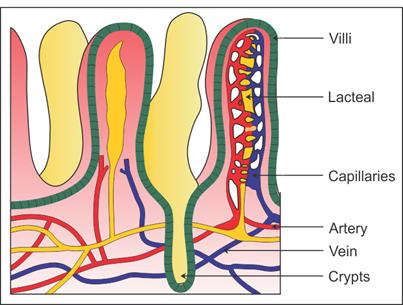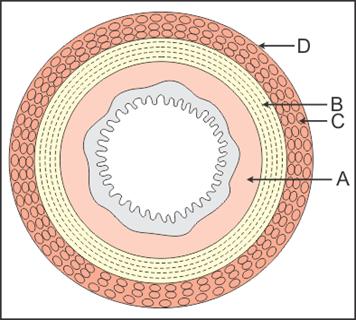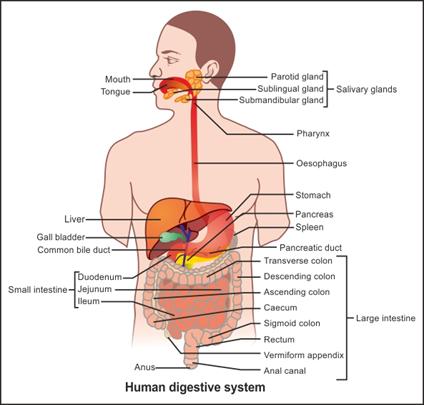Q1. Which of the
following is the largest gland in an adult man?
Solution
The liver is the largest glandular organ in the body and performs many
vital functions to keep the body pure of toxins and harmful substances. It is
a vital organ which supports nearly every organ in the body in some way. Without
a healthy liver, a person cannot survive. An average adult liver weighs about
three pounds.
Q2. Bile contribution to digestion is
Solution
The liver secretes bile which is stored in the gall bladder. Bile salts help in the digestion of fats in the small intestine which converts large fat droplets into small ones. This process is called emulsification.
Q3. ‘Crypts of Lieberkühn’
are found in
Solution
The ‘Crypts of Lieberkühn’ (also known as
the intestinal glands) are glands found in the walls of the small intestine.
The crypts which are embedded within the epithelial lining secrete various
enzymes, including sucrase and maltase.
Q4. The enzyme pepsin acts in
Solution
Pepsin hydrolyses proteins into short polypeptides in an acidic medium of pH 2.0 in the stomach.
Q5. Peptic cells
secrete
Solution
Peptic cells of the gastric glands secrete digestive enzymes such as pepsin
and lipase.
Q6. Name the enzyme secreted by the peptic cells.
Solution
Pepsinogen
Q7. State the role of lysozyme present in the saliva.
Solution
Lysozyme acts as an anti-bacterial agent and prevents infections.
Q8. The richest
sources of Vitamin B12 are
Solution
Vitamin B12 is the only vitamin which is not found in vegetables. It
is present in animal protein such as meat, liver, fish and Spirulina. It
promotes DNA synthesis, maturation of RBCs and myelin formation.
Q9. Which one of the following is a matching pair of a substrate and its particular digestive enzyme?
Solution
Intestinal juices contain several oligosaccharides which hydrolyse specific polysaccharides into their monosaccharides. Maltase is one of them, which hydrolyses maltose into two glucose molecules.
Q10. How many teeth appear twice during the lifespan of an individual?
Solution
The teeth which appear twice during the lifespan are the milk teeth (8 incisors, 4 canines and 8 molars) which are temporary and erupt when the child is about 6 months old. They again appear by the end of 24 months.
Q11. Kwashiorkor
disease occurs due to deficiency of
Solution
Kwashiorkor is caused by deficiency of protein in the diet.
Q12. Name the hormone which stimulates
the secretion of gastric juice.
Solution
The hormone which stimulates the secretion of gastric juice is
gastrin. It is secreted by the parietal cells of the stomach and aids in
gastric motility.
Q13. Carbohydrate
digestion first occurs in the
Solution
Carbohydrate digestion starts in the oral cavity, in which the food is
mixed with saliva which then moves into the stomach.
Q14. Chief cells of the gastric glands are
Solution
Gastric glands are numerous microscopic, tubular glands formed by the epithelium of the stomach.
Q15. Anxiety and eating spicy food together in an otherwise
normal human may lead to
Solution
Anxiety and
eating spicy food together in an otherwise normal human may lead to
indigestion.
Q16. Why are humans called heterodonts?
Solution
Human beings show the presence of four types of teeth, i.e. canines,
incisors, molars and premolars. Hence, they are called heterodonts.
Q17. Explain the role of the buccal cavity during digestion.
Solution
The buccal cavity performs mastication of food and facilitates swallowing.
The teeth and tongue mix the food thoroughly with saliva.
The mucus present in the saliva helps in lubricating food, and it also
adheres masticated food particles together into a bolus.
The bolus is then swallowed and conveyed into the pharynx.
Q18. In man, the
zymogen or chief cells are mainly found in
Solution
Chief cells or zymogen are mainly found in the
fundic part of the stomach.
Q19. When breastfeeding is replaced by less nutritive food low in proteins and calories in infants below the age of one year, they are likely to suffer from
Solution
Prolonged starvation causes marasmus due to a generalised wasting of body because of both energy and protein deficiency. The body becomes lean and weak, the eyes are depressed and the skin is wrinkled.
Q20. Which of the following is a fat-soluble vitamin and its related deficiency disease?
Solution
Vitamin A (retinol) and Vitamin D (calciferol) are fat-soluble vitamins, but the deficiency of calciferol causes rickets and osteomalacia.
Xerophthalmia is caused by deficiency of Vitamin A.
Q21. Digestive enzymes are
Solution
Any enzyme which uses hydrolysis (breaking
a molecule in two, resulting in two smaller molecules) is called a hydrolase.
In chemical digestion, hydrolysis is the
main chemical reaction
used by the enzymes to break proteins, lipids, carbohydrates and other
complex molecules into smaller pieces.
Q22. Which one of the following pairs is not correctly matched?
Solution
Vitamin B2 helps in RBC production. Its deficiency causes cheilosis.
Q23. The crown of
teeth is covered by
Solution
Of the three regions of the teeth, the part which projects above the
gums is the crown which is covered by enamel, the hardest substance of the
human body.
Q24. Where do you find the sphincter of Oddi?
Solution
The sphincter of Oddi is situated between the opening of the
hepatopancreatic duct and the duodenum.
Q25. Calcium deficiency
occurs in the absence of vitamin
Solution
Vitamin D mainly helps in the Ca/P balance of body fluids. It
increases absorption of calcium from the intestines, so it is necessary for
formation of healthy bones and teeth.
Deficiency of Vitamin D causes an increased loss of calcium ions in
urine; thus, calcium ions get deposited in the bones. This causes rickets in
children and osteomalacia in pregnant woman.
Q26. Name three secretions released into the small intestine.
Solution
Bile, pancreatic juice and intestinal juice
Q27. What is assimilation?
Solution
Assimilation is the use of absorbed food or nutrients by the tissues.
Q28. Secretin and cholecystokinin are digestive hormones. These are secreted
by
Solution
Secretin and cholecystokinin are two main
gastrointestinal hormones secreted in the duodenum of the alimentary canal.
Cholecystokinin stimulates gall bladder contraction and thus increases the
flow of bile salts into the intestine.
Secretin stimulates the release of an alkaline pancreatic fluid which neutralises
stomach acid as it enters the intestine.
Q29. Write any five reactions which occur in the duodenum.
Solution

Q30. Which one of the following hydrolyses internal phosphodiester bonds in a polynucleotide chain?
Solution
The groups of enzymes which catalyse the hydrolysis of phosphodiester bonds between nucleic acids in a polynucleotide chain are endonucleases.
Q31. The pancreas produces
Solution
The pancreas produces pancreatic juice which contains trypsinogen, chymotrypsin, carboxypeptidase, lipase, pancreatic alpha amylase, elastase and nucleases. Of these, the first three are concerned with protein digestion which converts proteins into small peptides.
Other than these, the pancreas also secretes the hormones insulin and glucagon which act antagonistically in controlling the blood sugar level.
Q32. Write any two causes of indigestion.
Solution
Inadequate enzyme secretion and anxiety
Q33. Name the valve which prevents the backflow of the faeces into the large intestine.
Solution
Ileocaecal valve
Q34. For a person suffering from high blood cholesterol, the physicians recommend
Solution
A high intake of saturated fat causes high blood cholesterol which ultimately gets deposited in the walls of the arteries causing their blockage resulting in various cardiac diseases. Ghee, butter, red meat and vanaspati are rich sources of saturated fats. A patient with high blood cholesterol is suggested to consume unsaturated fats as vegetable oils.
Q35. Bile secretion is proportional to the concentration of
Solution
The liver secretes bile which is stored in the gall bladder. Bile
salts help in the digestion of fats in the small intestine which converts
large fat droplets into small ones.
Q36. Name the capsule which covers the hepatic lobule.
Solution
Glisson’s capsule
Q37. Name the layer which forms the serosa.
Solution
Mesothelium
Q38. State the role of the large intestine.
Solution
Role of the large intestine:
Water is absorbed in the large intestine,
and drugs and minerals are also absorbed to some extent.
The large intestine secretes mucus which
helps in adhering undigested particles together and lubricates them for
an easy passage outside the body.
Q39. Draw the diagrams of
Section of the small intestine
Arrangement of teeth human
Solution
Section of the small intestine:
 Arrangement of teeth human:
Arrangement of teeth human:

 Arrangement of teeth human:
Arrangement of teeth human:

Q40. Oxyntic cells secrete
Solution
Oxyntic cells (also called parietal cells) lie against the basement membrane and secrete hydrochloric acid.
Q41. Name the point of attachment between the tongue and the oral cavity.
Solution
Frenulum
Q42. Name teeth found in an adult human.
Solution
Incisors, canines, molars and premolars.
Q43. Stool of a person contains whitish grey colour due to malfunction of which type of organ?
Solution
Bilirubin is broken down to urobilinogen and stercobilinogen. The yellowish brown colour of stool is due to stercobilinogen. Due to the malfunctioning of liver, insufficient production of stercobilinogen leads to white stool.
Q44. ‘Glisson’s capsule’ is associated with
Solution
‘Glisson’s capsule’ is the capsule of the liver. It is a layer of connective tissue surrounding the liver and enclosing the hepatic artery, portal vein and bile ducts within the liver.
Q45. Where is the liver situated in the body? Name the structural and
functional units of the liver.
Solution
The liver is situated in the abdominal cavity just below the
diaphragm.
Hepatic lobules are the structural and functional units of the liver.
Q46. The gastric juice contains
Solution
Gastric juice is secreted by gastric glands which also secrete
digestive enzymes such as pepsin and rennin. The gastric glands also produce a
small amount of gastric amylase and gastric lipase.
Q47. Argentaffin cells in human beings are found in
Solution
Argentaffin cells, the round or partly flattened cells, occur in the tissue lining the stomach and contain granules thought to have a secretory function.
Q48. In humans, sphincter of Oddi is associated with the opening of
Solution
The sphincter of ampulla or sphincter of Oddi is a muscular valve which controls the flow of digestive juices (bile and pancreatic juice) through the hepatopancreatic ampulla into the second part of the duodenum.
Q49. Name the lymph vessel which joins villi.
Solution
Lacteal vessel
Q50. What will happen if the secretion of the parietal cells of the gastric glands is blocked within an inhibitor?
Solution
Gastric glands are numerous microscopic tubular glands formed by the epithelium of the stomach. The parietal cells are large and most numerous on the side walls of gastric glands. They secrete hydrochloric acid and Castle’s intrinsic factor. The peptic cells of gastric glands secrete gastric digestive enzymes as proenzymes (pepsinogen and prorennin) and a small amount of gastric amylase and gastric lipase. The hydrochloric acid maintains a strongly acidic pH of about 1.5 to 2.5 in the stomach.
Q51. Pepsinogen is secreted by
Solution
Pepsinogen and prorennin are gastric digestive enzymes secreted by the chief cells or peptic cells of the gastric glands.
Q52. Name the enzyme which gets activated due to enterokinase.
Solution
Trypsinogen
Q53. Pellagra is
caused by the deficiency of
Solution
A disease called pellagra is caused by deficiency of Vitamin B3.
Q54. Name various substances present in bile. State the functions of bile.
Solution
Various substances present in bile are bilirubin, biliverdin, bile
salts, cholesterol and phospholipids.
Bile helps in breaking down of the fats into small micelles, and this
process is called emulsification. Bile also helps in activation of lipases.
Q55. What is  ?
?
 ?
?
Solution
The dental formula of humans.
Q56. Name the cells which secrete HCl in the stomach.
Solution
Oxyntic cells
Q57. Study the given reaction and identify A.


Solution

Q58. State the optimum pH required for the action of salivary amylase on carbohydrates.
Solution
The optimum pH for the action of salivary amylase on carbohydrates is
6.8.
Q59. State the action of the following enzymes and the resulting end-product:
Carboxypeptidase
Sucrase
Nucleosidases
Amylase
Solution
Carboxypeptidase - It acts on proteins, peptones and proteoses.
The end-product is dipeptides.
Sucrase - Sucrase acts on sucrose, and the end-products are
glucose and fructose.
Nucleosidases - These enzymes act on nucleosides, and the end-products
are sugars and nitrogen bases.
Amylase - It acts on starch, and the end-product is
disaccharides.
Q60. Bile salts act as an activator of which enzyme?
Solution
Bile contains no enzyme, but it activates the enzyme lipase.
Q61. Vitamin K is
required for
Solution
Vitamin K is essential for the formation of prothrombin from liver
cells and helps in blood coagulation. Vitamin K is also known as
antihaemorrhagic factor or phylloquinone.
Q62. What is the optimal pH for pepsin in the stomach?
Solution
1.8 is the optimal pH for pepsins.
Q63. Given is the transverse section of the gut. Study the section and
label A, B, C and D.


Solution
A - Sub-mucosa
B - Inner circular muscularis
C - Outer longitudinal muscularis
D - Serosa
Q64. State the term used for the protein-coated fat droplets.
Solution
Chylomicrons
Q65. Name the region of the large intestine where symbiotic microorganisms
take their shelter.
Solution
Caecum
Q66. Why are humans called thecodonts?
Solution
In humans, teeth are embedded in the
sockets of the jaw bone, and such type of attachment is called thecodont. Hence,
humans are called thecodonts.
Q67. Name the ions present in the saliva.
Solution
The ions present in saliva are Na+, K+, Cl− and HCO3−.
Q68. Name the bile pigments present in bile.
Solution
Bilirubin and biliverdin
Q69. What kinds of muscles are present in the muscularis layer of the
alimentary canal?
Solution
Smooth muscles
Q70. What is the technical term for swallowing food?
Solution
Deglutition
Q71. What are partially hydrolysed proteins called?
Solution
Peptones
Q72. Name the movements which help to pass the food down through the oesophagus.
Solution
Peristalsis
Q73. Name the enzyme which digests milk proteins in infants.
Solution
Rennin
Q74. Name the two ducts which form the bile duct.
Solution
The cystic duct and the hepatic duct join to form the common bile duct.
Q75. Name the three types of cells present in the gastric glands of the stomach, and also state their secretions. Also state the significance of the secretions.
Solution
The three types of cells found in gastric glands and their secretions are
Mucus neck cells secrete mucus. Mucus provides lubrication and protection to the mucosal epithelium from the excoriating effect of HCl.
Peptic or chief cells secrete pepsinogen. Pepsinogen converts proteins into proteoses which are further converted into peptones.
Oxyntic cells or parietal cells which secrete HCl and intrinsic factors. HCl provides acidic pH 1.8 which is necessary for the action of pepsins. Intrinsic factors are required for the absorption of vitamin B12.
Q76. Explain diphyodont dentition.
Solution
Dentition in which animals exhibit two kinds of teeth in their life - first
deciduous teeth and second adult teeth - is called diphyodont dentition.
Q77. What is diarrhoea? Why do skin and eyes turn yellow in jaundice?
Solution
Diarrhoea is the abnormal frequency of bowel movement which increases
the liquidity of the faecal discharge.
In jaundice, due to the deposition of bile, the skin and eyes turn
yellow.
Q78. State the four layers of the walls of the alimentary canal.
Solution
The four layers of the walls of the alimentary canal are
Outermost serosa made of mesothelium.
Middle muscularis formed of smooth muscles arranged in inner circular and outer longitudinal layers.
The inner mucosal layer formed of the loose connective tissue containing nerves, blood vessels and lymph vessels.
The innermost layer is the sub-mucosal layer which lines the lumen and consists of rugae and villi.
Q79. Name the gland present in the lower jaw.
Solution
Sub-maxillary gland
Q80. Name the enzymes present in the saliva.
Solution
Salivary amylase and lysozyme
Q81. In which region of the small intestine are the simple substances
absorbed in blood?
Solution
Jejunum and ileum
Q82. Where are the pyloric sphincters present?
Solution
Pyloric sphincters are present between the stomach and the small
intestine.
Q83. Draw an outline of the human digestive system. Label any ten parts.
Solution
Human digestive system:
 (Label any ten parts)
(Label any ten parts)
 (Label any ten parts)
(Label any ten parts)
Q84. State the common name given to the secretions of the intestinal mucosa
and the secretions of the goblets cells.
Solution
Succus entericus
Q85. What is the technical term used for temporary milk teeth?
Solution
Deciduous teeth
Q86. Name the duct which releases bile and pancreatic juice. Where are these juices released? Name the inactive enzymes present in the pancreatic juices.
Solution
The hepatopancreatic duct releases bile and pancreatic juice. These juices are released into the small intestine. The enzymes present in the pancreatic juices are trypsinogen, chymotrypsinogen, procarboxypeptidases, amylases, lipases, nucleases etc.
Q87. What is the function of the gastro-oesophageal sphincter?
Solution
The gastro-oesophageal sphincter regulates the opening of the oesophagus into the stomach.
Comments
Post a Comment